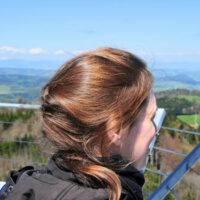Hi IdaliK –
Welcome to My Swiss Alps!
That is quite a challenge.
First, I’ll say that most Swiss can tell where they are by looking at the style of buildings, and any mountains that they can see. A trivial example is Emmental construction; see attached. The Alps are visible through out much of Switzerland, as in one of those images.
My way of placing myself in Switzerland is to use these two other senses in addition to seeing.
For me, hearing and taste are important. The food is different in the different regions, and the 4 national languages ( visible on signage as well as overheard) mean a lot. Especially in the German-speaking region, local variants of the lower Allemanic language used at home produce very distinct accents, and have differing grammars and vocabularies. What we call “German” is used for official and written communication. Perhaps mistakenly called “High” German it is better referred to in Switzerland as Schriftdeutsch. meaning “writing German.” It is irritating for a Swiss citizen to hear the somewhat arrogant “High” word attached to the somewhat standard version of the language spoken in most of Germany. However, it is common usage throughout the world in discussions of languages to hear of “High German” and ” Low German.”
At home, families use the local dialect of “Swiss German.” In dealing with foreigners, in business meetings with citizens of different parts of Switzerland ( if German is the language chosen for the meeting) or in official communications, “High” German is spoken.
If you have studied any German in school in the USA, you will quickly learn to recognize a distinctive Zürich accent ( as one example), so that the regional differences in Swiss German carry over to a meaningful degree in when the Swiss speaker uses “High” German. I can use that to give me clues on location.
Think of variations on Southern US accents, y’all, or New England accents, when you. “pahk your cah in Hahvahd Yahd.”
I don’t know if there are regional variations in Swiss French, which has its own peculiarities vs. French French.
However, it is a small country, and the Swiss often do move from their birth canton, so regional differences sometimes blur.
Finally, the job is a lot easier if you make comparisons in pairs…one on one.
Slowpoke




